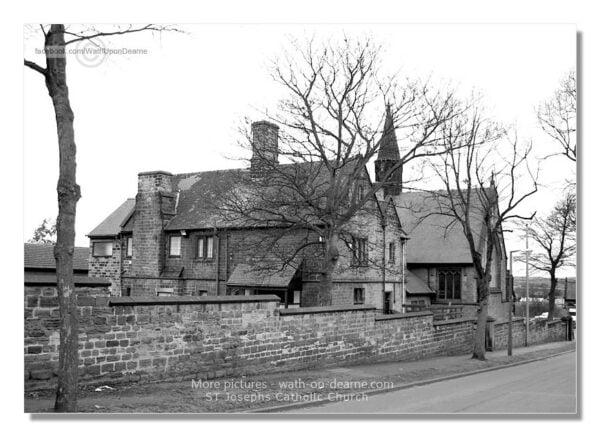 Nestled amidst the thriving locale of Wath-upon-Dearne, lies Saint Joseph’s Roman Catholic Church, an enduring symbol of faith in the Diocese of Hallam. This thriving spiritual hub, serving the faithful across South Yorkshire, parts of the High Peak, Chesterfield Districts of Derbyshire, and the District of Bassetlaw in Nottinghamshire, is cradled beneath the protective shroud of Our Lady of Perpetual Help. The veneration of the divine Lady is so profound within the Diocese that Her feast is observed as a solemnity each year on the 27th of June.
Nestled amidst the thriving locale of Wath-upon-Dearne, lies Saint Joseph’s Roman Catholic Church, an enduring symbol of faith in the Diocese of Hallam. This thriving spiritual hub, serving the faithful across South Yorkshire, parts of the High Peak, Chesterfield Districts of Derbyshire, and the District of Bassetlaw in Nottinghamshire, is cradled beneath the protective shroud of Our Lady of Perpetual Help. The veneration of the divine Lady is so profound within the Diocese that Her feast is observed as a solemnity each year on the 27th of June.
Born out of the bifurcation of the Dioceses of Leeds and Nottingham on the 30th of May, 1980, the Diocese of Hallam derives its appellation from the ancient name of the region – Hallamshire. It stands as one of the six proud suffragan see’s of the ecclesiastical Province of Liverpool. Overseeing this spiritual expanse, since the 10th of July, 2014 is Bishop Ralph Heskett, C.Ss.R. an illustrious figure, previously the Bishop of Gibraltar.
The pulse of this Diocese, however, is palpable not only in the quiet sanctity of its church but also in the bustling corridors of Our Lady and St. Joseph’s Catholic Primary School on Fitzwilliam Street, and St. Pius X Catholic High School on Wath Wood Road.
The inception of the Saint Joseph’s Roman Catholic Church was a consequence of an earnest endeavour to better attend to the spiritual needs of the Catholics in the region. It started as a reverberating echo of Fr. Charles James Locke’s letter to the Bishop of Beverley in 1876, proposing the creation of a sacred space. Initially, a modest conversion of the billiard room at Cross House, the home of Margaret Cadman, was considered. However, in a grand turn of events, the Cadman family, together with the affluent Nicholsons, laid the financial groundwork for a new church and presbytery.
The church, adorned with Gothic influences, sprung from the vision of M. E. Hadfield and his son Charles, supported generously by the two locally revered Catholic families. The grand doors of this sacred structure were first opened to the public on a sunny May Day in 1879 by Bishop Cornthwaite of Leeds.
Resembling the design of St. Joseph’s at Handsworth, the church flaunts the Perpendicular Gothic style, typical of the late fifteenth-century architecture of the region. It comfortably accommodates up to 300 faithful, ushered in under a lofty stone spirelet marking the division between the nave and the chancel.
The entrance is gracefully accentuated by a niche, featuring the figure of St. Joseph cradling the Infant Saviour. Passing through the massive oak doors, one is welcomed by a well-proportioned interior with a nave and a chancel, originally furnished with oak benches or choir stalls. A splendid eastern window gifts the inside of the church with a divine luminescence. The intricate stained glass depicts the crucifixion, the Blessed Virgin and St. John, St. Agustine, St. John of Beverley, St. Ann and St. Mary Magdalene. A generous offering by Miss Cadman, these windows are the masterpieces of the firm Lavers, Barraud, and Westlake.
The erstwhile stone-carved font that once held its place in the north-west corner of the nave was replaced in the grand reordering of 1981, as were the rails separating the nave and sanctuary. The nave now bears the warm and quiet semblance of carpeted blue and red Staffordshire quarries, whereas the chancel is adorned with a carpet over the pavement of Goodwin’s encaustic tiles.
The reredos, a stunning addition from 1886, runs across the eastern end of the chancel. Housing niches of Beer-stone, it hosts the statues of St. Peter and St. Joseph. Below the Tabernacle, a sculpture of the dead Christ, supported by angels, adds to the artistic grace of the Church. Crafted by Frank Tory from the Sheffield School of Art and Mr. Wall of Cheltenham, these pieces stand testament to the artisanal brilliance of the era.
The 1981 reordering also witnessed the relocation of the shrine to Our Lady from between the confessional and the entrance to the sacristy. The entirety of this makeover was brought to life by the capable hands at Ormsby of Scarisbrick.
Saint Joseph’s Roman Catholic Church continues to be a beacon of faith and spirituality, its narrative interwoven with the rich tapestry of the region’s history, architecture, and people.
Editor’s Comment:
In this evocative depiction of Saint Joseph’s Roman Catholic Church and its history, readers are taken on a captivating journey through time. The Church, deeply embedded in the spiritual fabric of Wath-upon-Dearne, emerges as a compelling beacon of faith, not only for the devout Catholic population but also as an architectural marvel that draws admiration from the aesthete. The transformation of the Church over the years reflects a careful interplay between preservation and progress, underlining the dynamic nature of spiritual spaces.
The significance of this Church extends beyond its physical boundaries, serving as a spiritual guide for the schools it influences, and imbuing its teachings into the hearts of the young. The Church’s profound influence is a testament to the power of faith, community, and shared history.
The strength of this article lies in its ability to transport readers, transcending the mere written word, to experience the Church’s profound sense of peace and reverence. Through the captivating narrative, readers can feel the cool shade of the towering spirelet, hear the whispers of the now silent bells, and witness the ever-changing dance of light through the stunning stained glass windows.
It’s our hope that this piece resonates with readers, regardless of their faith, imparting an appreciation for the intricate tapestry of history, architecture, and spirituality that is Saint Joseph’s Roman Catholic Church.

My father, VINCENT ROWAN, was born 16 August 1914 and the family moved to 12 Riley Road, Wath upon Dearne in 1922.
His father was James and his mother, Sarah, died in 1929.
Are there any records of my father at your school and/or in your parish.
Phillip Rowan